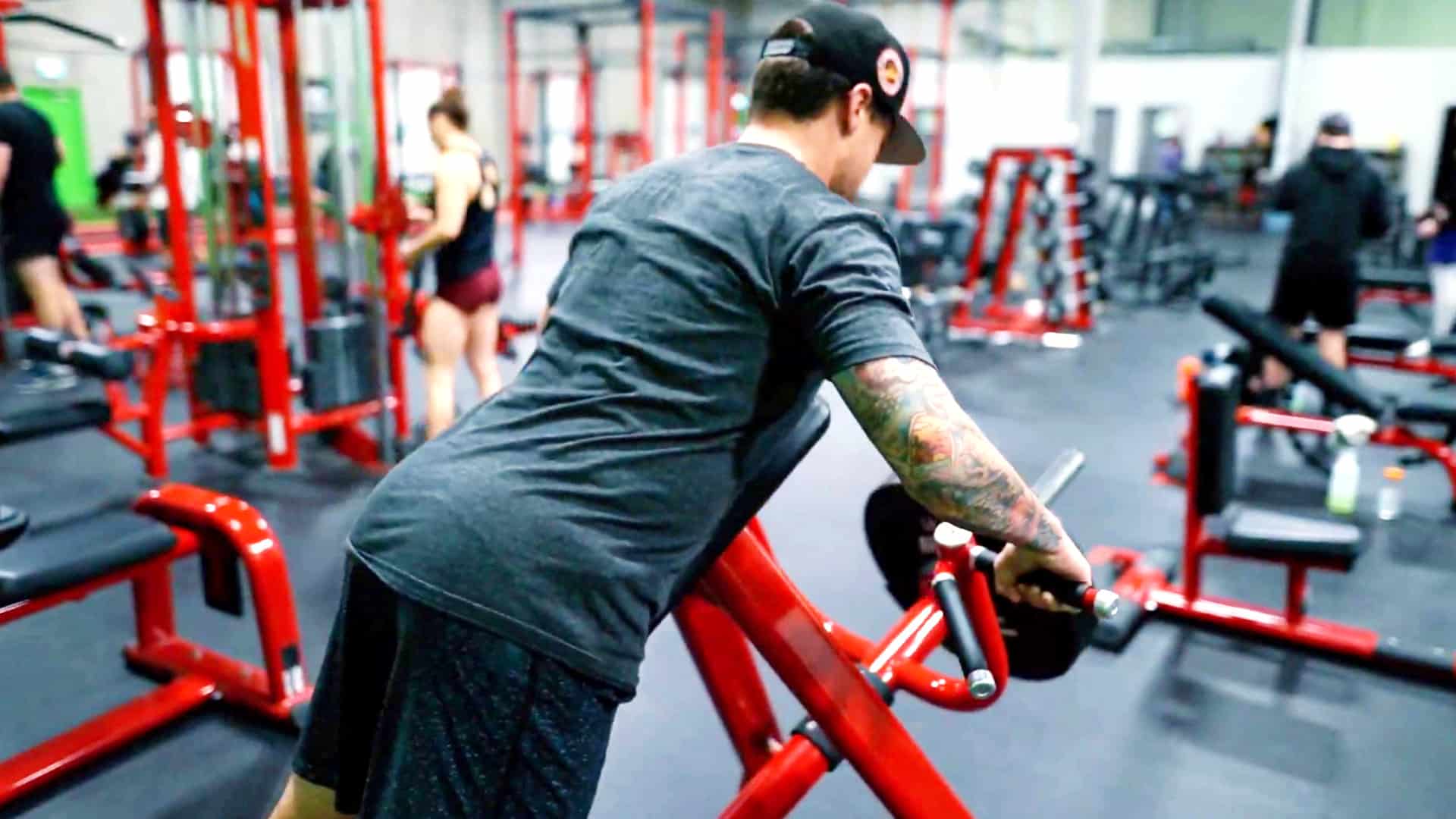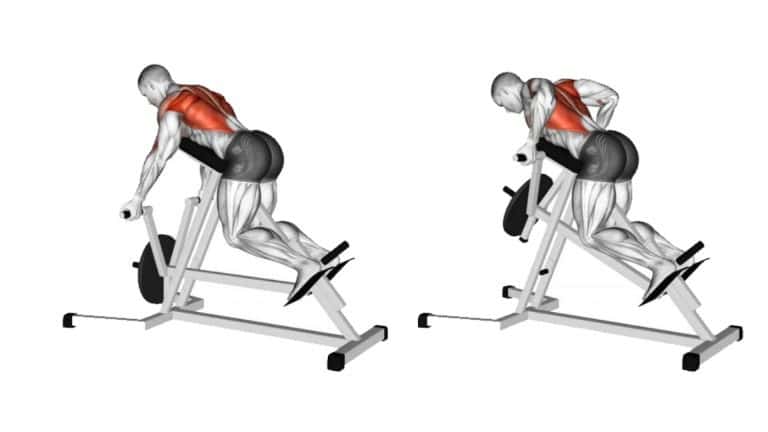The chest-supported T-bar row exercise, also called chest-supported machine row, is similar to the T-bar row. It helps you work most of the back muscles including your lats, rhomboids, and middle trapezius.
Use a T-bar row machine with a chest pad for support to do a chest-supported T-bar row. The fixed angle of the chest pad puts your body in a mechanically advantageous position. This allows you to lift heavier weights without compromising form.
Unlike bent-over rows or T-bar rows, chest support removes most of the stress from the lower back.
This row variation requires less effort to stabilize body position during the row because one end of the bar pivots at a fixed point on the floor, and the chest is supported on the bench.
The chest-supported T-bar row is most commonly incorporated into exercise routines that require significant hypertrophic muscle growth and neurological adaptation.

Chest Supported T-bar Row Muscles Worked
A chest-supported T-bar row is a compound exercise that simultaneously works for many muscle groups.
- The primary muscle groups that worked during the chest-supported machine row were the latissimus dorsi, scapula, rear deltoid, and trapezius muscle groups.
- The secondary muscles worked during the chest-supported T-bar row are: Rhomboids, Biceps, brachialis, Brachioradialis and Infraspinatus.
- Antagonist Muscles worked: Chest, triceps, front deltoid.
- The leg muscle groups are accessory dynamic movement stabilizers or simple static support stabilizers.

How To Do Chest Supported T-bar Row
- Place your feet on the platform and your chest and abdomen on the angled pad.
- With your knees slightly bent, find a comfortable position with the T-bar row machine’s chest support pad pressed against your entire sternum.
- Grasp the bar with a shoulder-width grip, unrack it, and begin with your arms extended in front of you.
- Gripping the bar either with a T-bar row grip or simply by the barbell itself, squeezing your scapula together while drawing your elbows towards your back.
- Raise the weight plates towards your chest, completing the concentric portion of the exercise.
- Ensure that your back is completely stable and straight throughout this exercise.
- Slowly return the weight to the starting position by straightening your elbows and allowing your shoulder blades to come forward.
- Don’t relax and let the weight fall back towards the ground. Keep it under control the whole time.
- Completed the desired number of reps.
Tips and Form
- Ensure your chest is firmly pressed against the support pad. Adjust the pad to support your sternum to provide a strong base without limiting your range of motion.
- Keep your elbows close to your body as you row. Flared elbows can shift the focus away from your back and place undue stress on your shoulders.
- Actively brace the core and slightly tilt the hips forward.
- Extend the bar as high as the apparatus will allow, pause briefly at the top, and then lower to a full stretch at the bottom.
- Make sure to keep the shoulder blades retracted throughout the entire movement.
- Do not relax during the lowering phase.
- Use lighter weights. This exercise can be challenging to perform with a heavy load. The pressure of the chest pad causes the chest to become greatly compressed, making it difficult to breathe.
- Experiment with different grip widths to target specific areas of your back. A wider grip emphasizes the lats, while a narrower grip works the rhomboids and traps.
Use Our Free Calculator To Know Your Muscle Building Calories Requirement
Supported T Bar Row Hand and Grip Position
Here are some ways you can alter your row to hit different muscles.
Grip Position
1. Overhand Grip
The overhand grip will target the upper back more. Because the elbows will push out from the body, the upper back and delts will receive increased activation.
2. Underhand Grip
On the other hand, an underhand grip will force the elbows to stay close to the body. This will generally cause greater activation of the middle and lower traps. You will get more bicep activation because of elbow extension.
3. Neutral Grip
Various elbow angles can be used with a neutral grip. However, its main benefit is that it takes stress off the elbow. Because of this, people who suffer from elbow pain will love using a neutral grip.
Grip Width
1. Narrow Grip
Using a narrow grip usually causes your elbows to drop, which causes you to pull lower. This will hit your lats, middle, and lower traps more. Additionally, the biceps receive a greater workout with a higher range of motion.
2. Wide Grip
A wide grip will force you to use an overhand grip and force your elbows out. This will enhance the emphasis on the rhomboids and rear deltoid.
Other Variations of Supported T Bar Row
The chest-supported t-bar machine row can be performed with different grip variations, such as an overhand, reverse, or neutral grip.
- If you are new to performing it, you may want to apply a few modifications to make the exercise easier. One way to counter this problem is to use a lighter weight. Another is to use a neutral grip chest-supported T-bar Row.
- If you are looking for a more advanced variation to stimulate different muscle fibers in the back, then try reverse grip chest-supported T-Bar row
1. Reverse Grip Chest Supported T-Bar Row
The reverse grip T-bar row is a strength training exercise that works the same muscles as rowing a boat. The goal is to strengthen the muscles that move the arms toward the body and the muscles that move the shoulder blades toward the spine.
Because of the hand position, reverse grip t-bar rows can allow you to lift medium weight and achieve a more significant contraction of back muscles.

Conclusion
This exercise is highly recommended for anyone interested in building back strength and gaining muscle size. It allows for targeted muscle development and provides an overall upper body workout.
If you do these back exercises consistently, the results will speak for themselves.
Thanks for reading
Stay Fit, Live a Happy and Healthy Life

Manish is a NASM-certified fitness and nutrition coach with over 10 years of experience in weight lifting and fat loss fitness coaching. He specializes in gym-based training and has a lot of knowledge about exercise, lifting technique, biomechanics, and more.
Through “Fit Life Regime,” he generously shares the insights he’s gained over a decade in the field. His goal is to equip others with the knowledge to start their own fitness journey.
